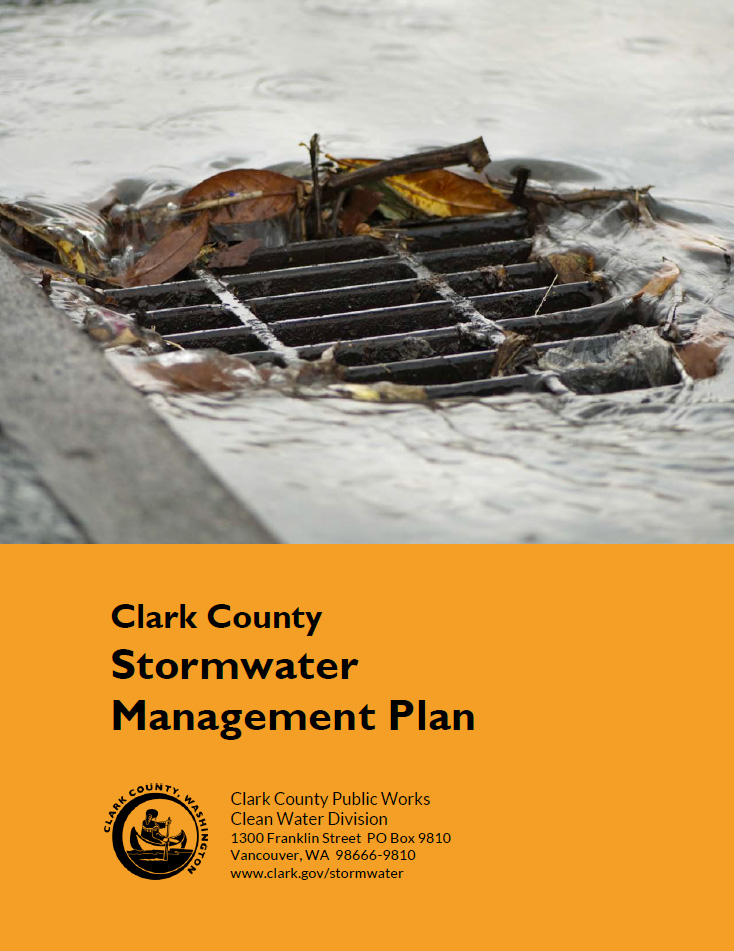Clark County's Stormwater Management Plan (SWMP) describes how stormwater and related water quality issues are managed. The plan also describes the county's actions to meet requirements of an NPDES Phase I Municipal Stormwater Permit issued in July 2019. The plan outlines all of the Clean Water Division programs and how we do business.
Clark County has had a SWMP since 2008. Updated versions are submitted to the Department of Ecology every spring and posted on the county website by May 31st. The SWMP includes information on all permit requirements per Section S5.C.
The updated SWMP is as follows:
- Clark County Stormwater Management Plan - 2025
(PDF 6 MB, updated March 2025)
Public Comments
Comments on the Clark County's SWMP can be submitted at any time by email to rod.swanson@clark.wa.gov or mailed to Rod Swanson, Clark County Clean Water Division, PO Box 9810, Vancouver, WA 98666-9810. The Clean Water Commission, appointed by the Clark County Council, provide and hear public input for the entire stormwater program. There is a public comment period at every meeting. For more information call (564) 397-4345.
SWMP Summary
Below you will find a short description of each chapter and section of the Clark County SWMP. You can also download a the summary in PDF form in multiple languages. Translation in other languages available upon request.
Chapter 1 - Introduction and Background
The Clark County SWMP describes the various ways the county meets its National Pollutant Discharge Elimination System (NPDES) stormwater permit requirements and manages stormwater and related water issues in the county’s unincorporated area. It acts as a guide for staff, resource for the public to learn about the county’s efforts and is required by the county’s municipal stormwater permit under sections S5.C.3.a. and S5.A.
Chapter 2 - Section 1 Legal Authority
This section describes the various codes, permits and authorities Clark County maintains to control discharges to and from its municipal separated storm sewer system (MS4).
Chapter 2, Section 2 - Inventorying and Mapping the Storm Sewer Infrastructure
This section outlines ways Clark County inventories and maps its storm sewer infrastructure and Class V injection wells. These efforts support many stormwater activities including inspection, operation and maintenance of the storm sewer system, illicit discharge detection and removal, drainage and source control support, stormwater assessment and monitoring, and capital planning.
Chapter 2, Section 3 - Operating and Maintaining the Storm Sewer System, County Property and Roadways
This section describes how the county inspects and maintains stormwater infrastructure to maintain its ability to convey, detain, infiltrate and treat stormwater. It also describes how Clark County manages its properties and roadways to reduce potential pollution sources such as erosion, fertilizers and pesticides.
Chapter 2, Section 4 - Detecting and Reducing Pollutants and Contamination
This section details the county’s efforts to eliminate illicit connections and discharges of contaminants to the storm sewer system. Efforts include regular inspections of business and multi-family properties to help ensure these sites are properly managing potential contaminants, maintaining stormwater infrastructure and preventing non-stormwater discharges from entering the public storm sewer system.
Chapter 2, Section 5 - Expanding and Improving the Stormwater Management Infrastructure
Expanding and improving stormwater infrastructure is the county’s primary means of controlling runoff from areas of new growth and fixing problems causes by uncontrolled runoff from existing developed areas. This section explains how the county accomplishes this through stormwater capital improvement projects, regulation development and construction projects.
Chapter 2, Section 6 - Public Involvement, Education and Outreach
This section describes Clark County’s ongoing opportunities for community members to provide input on stormwater management program activities. It also describes education and stewardship activities to teach various audiences about stormwater. The goal of these activities is to reduce or eliminate behaviors that adversely impact stormwater.
Chapter 2, Section 7 - Coordination
This section outlines how Clark County coordinates internally and with other local jurisdictions on a variety of environmental and planning topics as required under the NPDES stormwater permit.
Chapter 3 - Assessment and Monitoring
This chapter highlights how Clark County collects scientific data about stormwater, surface waters, stream corridor condition and habitat to support and implement NPDES permit requirements.
